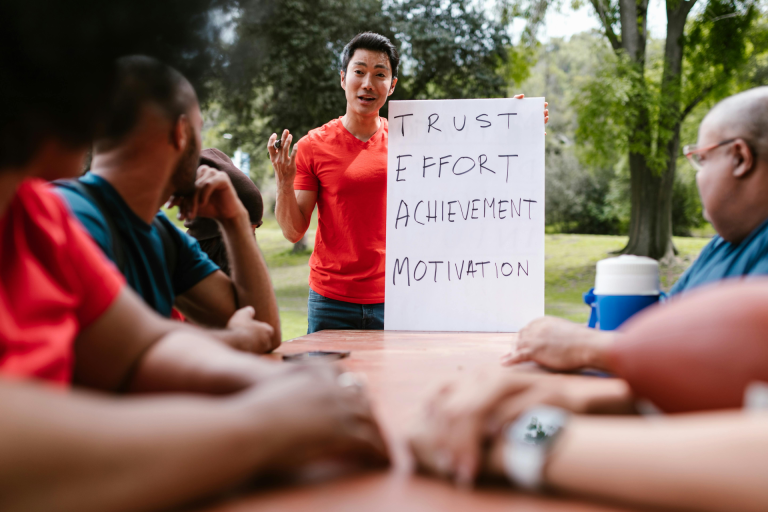What Makes a Good Team Leader
Are you interested in becoming a successful team leader?
We explore the key qualities that make a good team leader stand out, from effective communication and decision-making skills to empathy and emotional intelligence. We delve into the characteristics that set great leaders apart and discuss the responsibilities that come with leading a team, such as setting goals, delegating tasks, and providing support.
“A leader must inspire or his team will expire.” – Orrin Woodward

Learn how you can become a strong and effective team leader, transcending motivational biases along the way.
Qualities of a Good Team Leader
Good team leaders exhibit a range of essential qualities, including effective communication, strong decision-making skills, adept problem-solving abilities, efficient delegation, and unwavering motivation.
Communication Skills
Communication skills are paramount for a good team leader, encompassing traits such as empathy, trustworthiness, approachability, active listening, and constructive feedback mechanisms.
Effective communication within a team not only fosters understanding but also cultivates a sense of unity and collaboration among team members. Empathy enables a leader to relate to their team on a deeper level, enhancing team dynamics. Trust-building creates a foundation of reliability and mutual respect, essential for a smooth workflow.
Approachability encourages open dialogue and idea-sharing, creating a positive and inclusive team culture. Active listening ensures that every team member feels heard and valued, leading to increased engagement and productivity. Constructive feedback, when delivered effectively, helps team members grow and improve, ultimately benefiting the team as a whole.
Time Management Skills
Time management skills are crucial for a good team leader, involving organizational abilities, effective time allocation, adaptability to changing circumstances, and resilience in challenging situations.
Having strong time management skills allows a team leader to effectively prioritize tasks, delegate responsibilities, and create clear timelines for projects. By being organized and efficient in time allocation, a leader sets a positive example for the team, encouraging productivity and fostering a culture of accountability.
In dynamic environments, the ability to adapt quickly to unexpected changes is key to maintaining momentum and achieving goals. Resilience in the face of obstacles demonstrates leadership strength and helps inspire team members to overcome hurdles with determination.
Decision-Making Skills
Decision-making skills are vital for a good team leader, involving adept conflict resolution, assertive decision-making, fairness in judgment, and a drive for innovation and creativity.
Evaluating various perspectives and balancing the needs of team members, a leader must navigate through conflicting ideas to reach a consensus and propel the team forward.
“The strength of the team is each member. The strength of each member is the team.” Phil Jackson
Being assertive in decision-making is crucial for setting a clear direction and motivating others to achieve common goals. Fair judgment not only builds trust within the team but also fosters a positive work environment.
Check out the new Motivation Mentor AI Coach
app from Motivation Pay… It’s FREE!
Embracing innovation entails encouraging team members to think outside the box, experiment with new approaches, and continuously strive for improvement.
Problem-Solving Skills
Problem-solving skills are a cornerstone for a good team leader, encompassing creativity in finding solutions, open-mindedness to diverse perspectives, strategic thinking, and effective problem-solving approaches.
Fostering a team environment that values innovation and experimentation can magnify the impact of these problem-solving skills. By encouraging team members to think outside the box and consider fresh perspectives, a leader can tap into a wealth of creative solutions that might otherwise go unexplored.
Strategic thinking plays a crucial role in guiding the team toward its goals and aligning problem-solving efforts with overarching objectives. Effective problem-solving techniques, such as root cause analysis and SWOT analysis, help in diagnosing issues accurately and devising targeted solutions.
Empathy and Emotional Intelligence
Empathy and emotional intelligence are foundational qualities for a good team leader, involving self-awareness, strong interpersonal skills, and the ability to understand and connect with team members on an emotional level.
By cultivating empathy, a team leader can create a supportive and inclusive work environment where every team member feels valued and understood. This fosters trust among team members, enhances communication, and boosts overall team morale.

Emotional intelligence plays a crucial role in managing conflicts effectively, navigating challenging situations with tact and grace, and building strong relationships based on mutual respect and understanding. A leader who prioritizes emotional intelligence is better equipped to make informed decisions, inspire and motivate the team, and promote a collaborative and cohesive team culture.
Responsibilities of a Team Leader
A proficient team leader discerns the genuine spirit of a motivated self-starter, not merely through a resume or words, but through actions that exemplify drive and initiative. This insight prompts proactive measures to cultivate an environment where such qualities flourish.
Initiatives like personalized mentorship, challenging assignments, or platforms for idea sharing convert theoretical ideals into tangible actions, fostering a culture where motivation and self-starting behaviors thrive organically.
Setting Goals and Expectations
Setting clear goals and expectations is a fundamental responsibility of a team leader, requiring a vision for success, fostering team collaboration, and empowering individuals to achieve collective objectives.
By establishing clear goals, a team leader provides a roadmap for the team to follow, ensuring alignment toward a common purpose. This clarity not only enhances productivity and efficiency but also boosts morale and motivation among team members.
Effective goal-setting promotes accountability and allows team members to track their progress, celebrate milestones, and course-correct if needed. When expectations are communicated, team members understand their roles and responsibilities, leading to a more cohesive and harmonious working environment where everyone is working towards a shared mission.
Delegating Tasks
Effective task delegation is a critical responsibility of a team leader, involving trust in team members, understanding team dynamics, and monitoring performance to ensure successful task completion.
“Teamwork makes the dream work.” – Bang Gae
Delegating tasks effectively requires a deep understanding of each team member’s strengths and weaknesses, enabling the team leader to assign tasks that play to individual skills. By recognizing the unique contributions that each team member brings to the table, a leader can foster a collaborative and supportive team environment, which enhances overall productivity.
Team dynamics play a crucial role in task delegation, as the leader needs to balance workload distribution to optimize efficiency and performance outcomes. Regular evaluation of performance metrics allows for adjustments and feedback to further refine task allocation strategies for better results.
Active listening plays a crucial role in understanding team dynamics, concerns, and feedback, facilitating effective communication, and building trust within the team.
Providing Support and Guidance
Offering support and guidance is a key responsibility of a team leader, involving mentorship, coaching, providing assistance, and actively listening to team members’ needs and concerns.

By serving as a mentor, a team leader can impart valuable knowledge, skills, and advice to guide team members in their professional advancement.
Through coaching, leaders can help individuals identify strengths, areas for improvement, and growth opportunities. Assisting in overcoming challenges and obstacles can instill confidence in team members, fostering a positive work environment.
Active listening plays a crucial role in understanding team dynamics, concerns, and feedback, facilitating effective communication, and building trust within the team.
Managing Team Dynamics
Managing team dynamics is essential for a team leader, emphasizing collaboration, effective communication, fostering synergy, and building trust among team members.
It is paramount for a team leader to understand the diverse personalities and strengths within the team, ensuring that each member feels valued and heard. By implementing open lines of communication and actively listening to team members’ input, a leader can enhance team collaboration and cohesiveness.
Leveraging team synergies involves recognizing and capitalizing on individual strengths to achieve collective goals efficiently. Building trust within the team fosters a supportive environment where members feel safe to take risks, share ideas, and work towards a shared vision.
A team leader must establish effective feedback mechanisms to ensure open communication channels within the team.
Evaluating and Providing Feedback
Evaluating team performance and providing constructive feedback is a key responsibility of a team leader, involving creating a feedback loop, offering constructive criticism, recognizing achievements, and enhancing overall team performance.
A team leader must establish effective feedback mechanisms to ensure open communication channels within the team. By fostering a culture of transparency, team members feel encouraged to share their thoughts and ideas, leading to a more collaborative work environment.
Delivering constructive criticism respectfully and encouragingly is essential to helping team members grow and develop. Recognizing accomplishments and milestones, no matter how small, boosts morale and motivation levels, further driving team performance and unity.
Becoming an Effective Team Leader: Strategies for Success
Becoming a good team leader involves cultivating self-awareness, developing resilience, fostering innovation, engaging in effective coaching, and mastering the art of team building.
Continuously Develop and Improve Skills
Continuous self-improvement and skill development are essential for aspiring team leaders, involving a commitment to personal growth, continuous learning, and adaptability to evolving leadership challenges.
By actively cultivating leadership abilities, individuals can enhance their capacity to inspire and motivate their team members effectively. Embracing continuous learning allows leaders to stay updated with the latest industry trends, best practices, and technologies, enabling them to make informed decisions and navigate complex situations with confidence.
It is through actions, rather than words alone, that a leader truly influences and inspires their team to strive for excellence and uphold the values that define the team’s culture.
Staying adaptable in the face of changing leadership demands fosters resilience and agility, enabling leaders to pivot strategies, communicate effectively, and foster collaborative relationships within the team.
Lead by Example
Leading by example is a powerful strategy for aspiring team leaders, involving embodying the role model, demonstrating integrity, upholding ethical standards, and being a beacon of trustworthiness.
This leadership approach sets the tone for the team members, as they are more likely to follow suit when they observe a leader who practices what they preach. By consistently displaying ethical conduct and transparency in decision-making, a leader can earn the trust and respect of their team, fostering a positive work environment built on mutual trust.

It is through actions, rather than words alone, that a leader truly influences and inspires their team to strive for excellence and uphold the values that define the team’s culture.
Foster a Positive and Inclusive Environment
Creating a positive and inclusive environment is crucial for effective team leadership, involving fostering positivity, embracing diversity, promoting inclusivity, and nurturing a culture of teamwork.
- By building a culture that values each team member’s unique strengths and perspectives, leaders can encourage a sense of belonging, which boosts morale and sparks creativity within the team.
- When individuals feel valued and respected for their differences, it fosters a sense of trust and collaboration, leading to greater productivity and innovation.
- Embracing diversity not only enhances the richness of ideas within the team but also cultivates a sense of empathy and understanding among team members, fostering a supportive and cohesive work environment.
Encourage Open Communication and Collaboration
Encouraging open communication and fostering collaboration are key strategies for effective team leadership, involving transparency in decision-making, promoting communication channels, enhancing collaborative efforts, and strengthening teamwork bonds.
By prioritizing open communication, team members can share ideas more freely, leading to innovation and problem-solving efficiency. Transparent decision-making processes instill trust and accountability within the team, fostering a positive work environment. Effective communication practices ensure that information flows smoothly, reducing misunderstandings and conflicts while aligning everyone toward common goals.
This adaptability and understanding foster an environment where team members feel valued, seen, and motivated to contribute their best efforts.
Collaborative initiatives allow diverse talents to come together, creating a dynamic synergy that drives project success. Ultimately, promoting team cohesion leads to increased productivity, job satisfaction, and overall team performance.
Adapt to Different Situations and Team Members
Recognizing the importance of motivation in employees through adaptive leadership
In successful team leadership, adapting to diverse situations and understanding team members’ needs are paramount. This involves flexibility in approach, a deep understanding of individual strengths, empathetic responses, and tailored support.
This adaptability and understanding foster an environment where team members feel valued, seen, and motivated to contribute their best efforts. Flexibility in leadership allows for fluid responses to changing circumstances while recognizing individual strengths enables leaders to delegate tasks effectively. Empathetic communication further enhances trust and builds strong relationships, leading to higher team morale and collaboration.
By tailoring leadership approaches to each team member’s unique needs, leaders demonstrate care and investment in their development, ultimately enhancing team performance and success.







